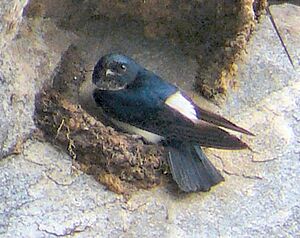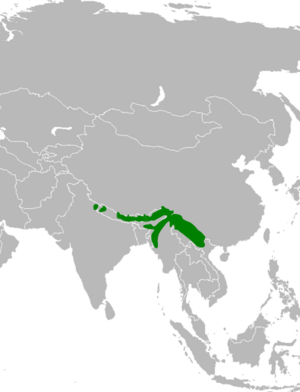Nepal house martin facts for kids
Quick facts for kids Nepal house martin |
|
|---|---|
 |
|
| At nest site in Bhutan | |
| Conservation status | |
| Scientific classification | |
| Genus: |
Delichon
|
| Species: |
nipalense
|
 |
|
| Resident range | |
The Nepal house martin (Delichon nipalense) is a small bird that belongs to the swallow family. Unlike many other swallows, it does not travel long distances (it's non-migratory). You can find this bird in the Himalayas, from northwestern India all the way to Nepal, Myanmar, northern Vietnam, and even a bit into China.
These birds live in river valleys and on rugged, wooded mountain ridges. They prefer heights between 1,000 and 4,000 meters (about 3,300 to 13,000 feet). They build their nests in large groups, often under rocky overhangs on tall cliffs. Each nest is made of mud and shaped like a cup, where the female lays three or four white eggs.
The Nepal house martin has a shiny blue-black back and a bright white patch on its lower back, called a rump. Its belly is also white. It looks a lot like its relatives, the Asian house martin and the common house martin. However, the Nepal house martin has a black throat and black feathers under its tail, which helps tell it apart. These birds fly together in groups with other swallows, catching flies and other insects right out of the air.
Contents
About the Nepal House Martin
The Nepal house martin was first described in 1854 by a British scientist named Frederic Moore. He gave it the scientific name Delichon nipalense. The name Delichon is a jumbled-up version of an old Greek word for "swallow." The word nipalense simply means "from Nepal," which is where the first bird studied was found.
There are a couple of slightly different types, or subspecies, of the Nepal house martin. One is found in the western Himalayas, and another, called D. n. cuttingi, lives further east in Myanmar and Vietnam.
Where They Live and Their Home
The Nepal house martin lives in the Himalayas, stretching from India through Nepal and Bangladesh to western Myanmar. The cuttingi subspecies is found in northern Myanmar and parts of China and Vietnam. These birds usually stay in the same area all year round. However, when it's not breeding season, they might fly down to lower altitudes, sometimes as low as 150 meters (about 500 feet).
Their favorite places to live are river valleys and mountains covered with trees, usually between 1,000 and 4,000 meters high. They mostly stay below 3,000 meters (about 9,800 feet). Even though they share some areas with the Asian house martin, they usually live at different heights, which helps prevent them from mixing.
What They Look Like
The adult Nepal house martin is about 13 centimeters (5 inches) long. Its upper body is mostly blue-black, and its underside is white. It has a very noticeable pure white rump. Its tail and upper wings are brownish-black, and the feathers under its wings are grey-brown. Its legs and feet are brownish-pink and covered with white feathers. Its eyes are brown, and its beak is black.
One special feature is its black chin. In birds from the eastern parts of their range, this black color can spread to cover the whole throat and upper chest. But in birds further west or south, the black is mostly just on the chin. Male and female birds look the same. Young birds are not as shiny and have a duller throat with slightly yellowish-brown underparts.
The eastern type, D. n. cuttingi, has slightly longer wings than the birds from the western Himalayas. Both types can be told apart from similar house martins because of their black chin, black feathers under their tail, and a much squarer tail shape.
This bird is a very fast flyer. It sometimes makes a short "chi-i" sound while flying, but it's generally a quiet bird. It does have a short, three-note song during the breeding season.
Life Cycle and Habits
Reproduction
Nepal house martins usually breed between March and July, and they often raise two sets of chicks each year. They build their nests under overhangs on vertical cliffs. The nest is a deep bowl made of mud, lined with soft grasses or feathers. Sometimes, they might even build nests on buildings, like under school roofs in Sikkim.
These birds like to nest in large groups, called colonies, which can have hundreds of nests! Some birds might even stay in the colonies all year, using the nests as a warm place to sleep in winter. The female usually lays three or four plain white eggs. Both parents help build the nest, sit on the eggs to keep them warm (this is called incubation), and feed the baby birds. We don't know exactly how long it takes for the eggs to hatch or for the chicks to be ready to fly, but it's probably similar to the common house martin, which takes about 14–16 days for eggs to hatch and another 22–32 days for the chicks to fly.
Feeding Habits
The Nepal house martin eats insects that it catches while flying. It hunts along mountain ridges or above the tops of trees. We don't know everything about their diet, but we do know they eat flies. These birds often fly and feed together in groups with other birds that catch insects in the air, like the Himalayan swiftlet or other swallows such as the barn swallow.
Natural Dangers
Not much is known about what animals hunt the Nepal house martin. However, one study found that it was the only bird eaten by a small bird of prey called the collared falconet, which mostly eats insects. These martins can also get tiny bugs called fleas.
Conservation Status
The Nepal house martin lives across a large area, and its population seems to be stable, meaning their numbers are not going down. Because their range is so big (more than 20,000 square kilometers or about 7,700 square miles) and there are many thousands of adult birds, they are not considered to be in danger. The IUCN (International Union for Conservation of Nature) lists them as "Least Concern," which means they are not currently at risk of disappearing. While they need specific cliff nesting spots, they are quite common in Nepal and very common in some areas.


